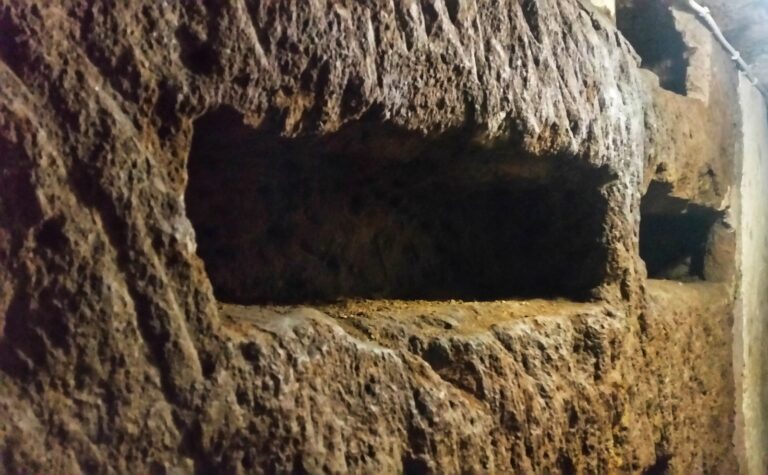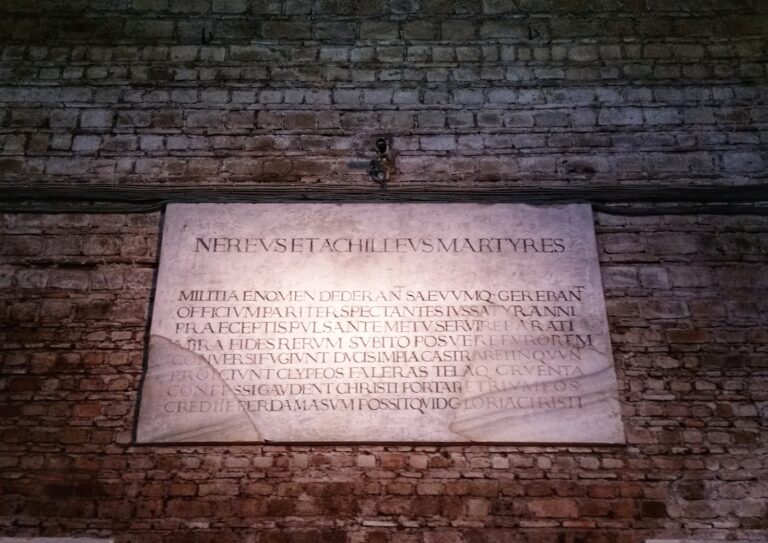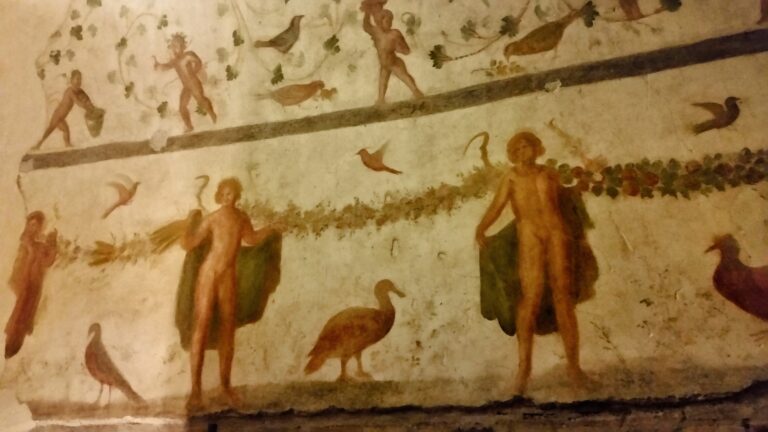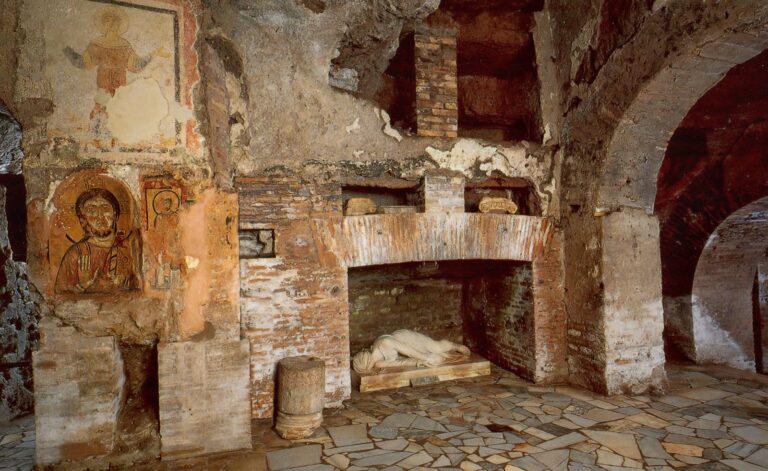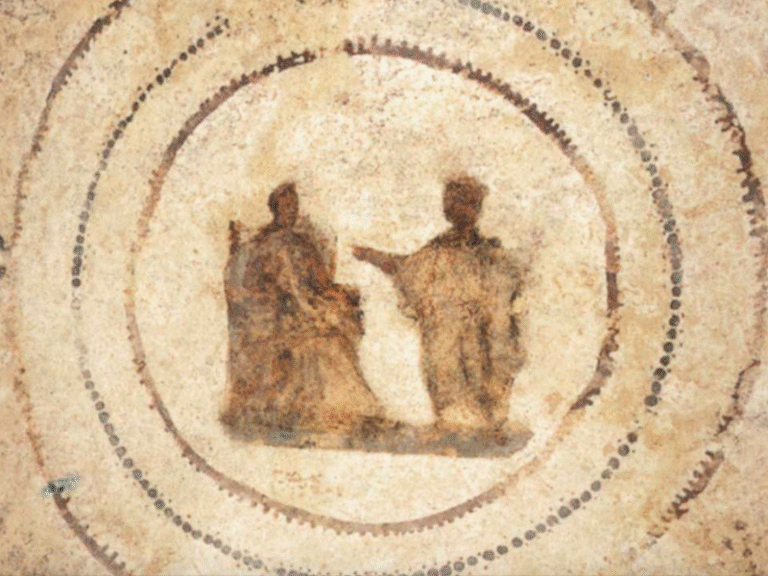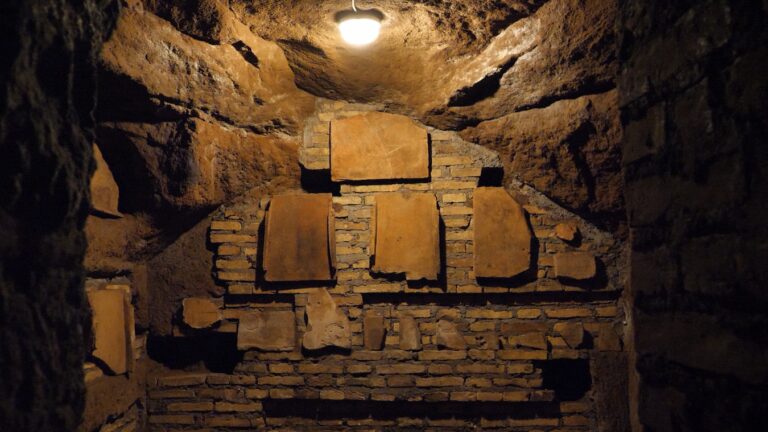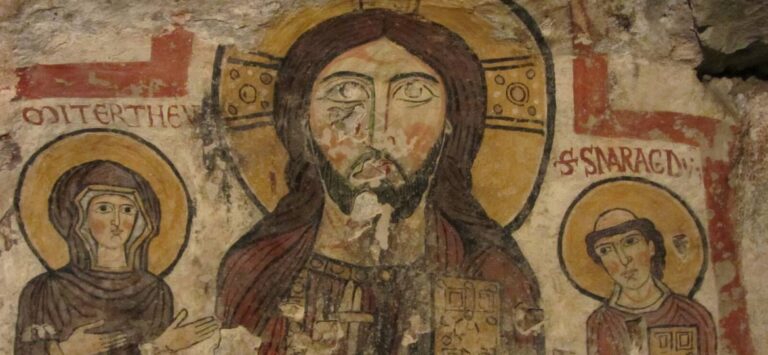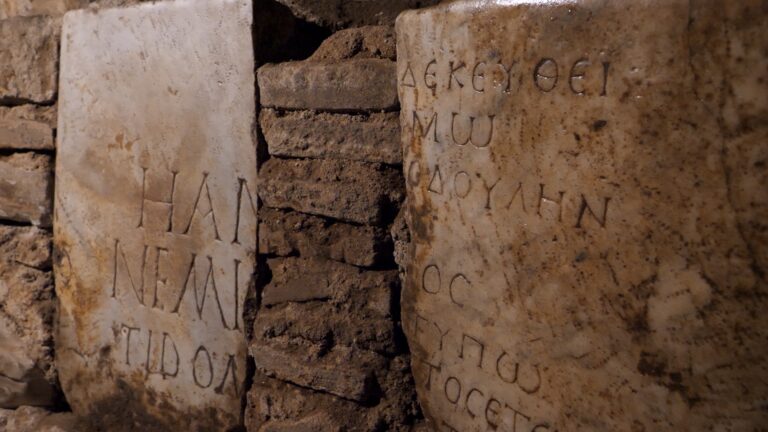Rome, it is often said, is like some great archaeological lasagne.
As if the stunning monuments that grace the streets of the Eternal City weren’t reason enough to make Rome one of the world’s most fascinating places, what you can see at first glance in Rome barely scratches the surface of the city’s riches. Thanks to its continuous habitation over thousands of years, an array of extraordinary historical sites lie concealed beneath the street level of the modern city, vast underground worlds hiding in plain sight just awaiting discovery by the intrepid traveller. And of all the subterranean sites in Rome, the catacombs are arguably the most fascinating .
In these passages and caves carved deep into the Roman bedrock beyond the ancient city walls, the city’s early Christian community came to bury their dead in the hope that they would remain undisturbed by those hostile to the new religion. But although these places are conditioned by death, we must remember that death was not the end for these early believers.
To understand these silent memorials in all their complexity, we must understand that they are as much celebrations of a glorious birth rather than commemorations of a sad death. In the shapes and forms of the wonderfully simple wall-paintings, carvings and inscriptions that survive in these tunnels, we can gain a unique insight into the world of early Christianity, and the distant thoughts and philosophies that animated these spaces millennia ago.
Read on to discover the most important catacombs that you can visit in Rome!
Rome Tours
Explore a Hidden Side of the Eternal City
The remarkably well-preserved Catacombs of Domitilla , located along the ancient Via Ardeatina, form one of the largest subterranean burial complexes in Rome. Dating back to the 2nd century, when the aristocratic Christian convert Flavia Domitilla donated land to the nascent church, the catacombs contain a vast network of galleries and tombs linked by labyrinthine tunnels carved out of the soft tufa rock characteristic of the Roman countryside.
The passages are lined floor to ceiling with narrow niches called niches which house the remains of countless early Christians. Small rooms, or cubicles , open out from the maze to reveal the final remaining places of families rich enough to enjoy the peace of private sepulchres. Strange symbols are engraved into their tombs – fish and anchors, secret signs that demonstrated the presence of Jesus Christ, messiah and savior of the Christian faith.
Wall paintings provide a window into the burial practices and beliefs of early Christians: allegorical images of plants and animals including phoenixes – symbolic of the resurrection – appear alongside depictions of important religious figures such as the twelve apostles, and one particularly fascinating portrait of a man identified as Diogenes, who appears with a pickaxe and shovel: it was his task to dig out the catacombs for the secure burial of his fellow Christians.
This extraordinary hidden world lay undiscovered for many centuries until it was unearthed in the late 1500s by Antonio Bosio, a man known as the ‘Columbus of the Catacombs’ for his intrepid adventuring spirit. He got lost for three days down here in search of the lost origins of Christianity, and it’s easy to see why even today, even with the aid of electric light illuminating the spooky way down towards the center of the earth.
Catacombs of Domitilla, Via delle Sette Chiese, 282. Opening Hours: from 9.00 to 12.00 and from 14.00 to 17.00. Closed on Tuesdays. Tickets €8, €5 reductions.

Historically the most easily accessible of the Roman catacombs, the small burial complex of San Sebastiano never slipped from the historical record as did the other entries on our list. Consequently, whilst perhaps being the most famous of the Roman catacombs, it has also suffered the depredations of grave robbers and material stripping more than its neighbours. Nonetheless, it still stands as a fascinating testament to the world of early-Christian Rome.
Believed to house the final remaining place of the highly revered 3rd-century martyr Saint Sebastian, moved here by the pious matron Lucina after he appeared to her in a dream, the catacombs are located beneath the church of San Sebastiano Fuori le Mura near the beginning of the Appian Way.
Originally a mine for pozzolana stone in antiquity, the site was adapted for pagan – and eventually Christian – burial from the 3rd century onwards.. Numerous graffiti referring to the apostles Peter and Paul attest to the site’s sacred significance for early Christians, and it has been theorized that the relics of the saints were briefly transferred here to a marble aedicule for safe-keeping in the 3rd century.
The so-called Cubicle of Jonah houses incredible early-Christian frescoes depicting the life of the prophet, while the Crypt of Saint Sebastian features a beautiful marble statue of the saint designed by Baroque master Gianlorenzo Bernini and sculpted by Antonio Giorgetti.
Catacombs of San Sebastiano, Via Appia Antica, 136. Opening Hours: from 9.00 to 12.00 and from 14.30 to 17.00. Tickets €8, €5 reductions.

Often referred to as the “Queen of the Catacombs,” thanks to the variety and extent of the early-Christian remains housed there, the Catacombs of Priscilla conserve over 40,000 bodies extending over 13 kilometers of tunnels excavated from the soft tufa rock beneath what is now the Roman park of Villa Ada.
Located along the ancient consular road Via Salaria, the complex occupies a particularly privileged place in Christian hagiography as a result of the numerous popes and saints interred here during the time of the Emperor Diocletian’s persecution of the new faith: Popes Marcellinus, Marcellus and Sylvester were buried here alongside notable saints including Felix, Philip, Praxedes and Pudenziana.
When the complex was rediscovered at the height of the Counter-Reformation in the 16th century, it caused a sensation. The cardinal and historian Cesare Baronio described how ‘all of Rome was filled with wonder’ at the find, ‘for it had no idea that in its neighborhood there was a hidden city, filled with tombs of the days of the persecutions of the Christians. ‘
Exceptionally high-quality paintings, including the oldest known depiction of the Virgin Mary and the infant Christ as well as a beautifully enigmatic fresco of a veiled woman dressed in liturgical vestments, make the catacomb an incredibly important site for art historians. The catacombs also feature a vast network of burial niches, adorned with frescoes depicting biblical scenes and symbols of Christian faith.
Counters and marble seating provide evidence that early Christians staged ritual banquets in honor of the dead down here, a fascinating memorial practice that is alluded to in a particularly fine depiction of a Eucharistic meal of bread and fish.
Catacombs of Priscilla, Via Salaria, 430. Opening Hours: from 9.00 to 12.00 and from 14.00 to 17.00. Closed Mondays and the month of August. Tickets €8, €5 reductions.

The Catacomb of San Callisto is the oldest and best preserved of the cemetery complexes on the Appian Way. Dating back to the 2nd century AD, the catacombs served as the final resting place for numerous prominent early Christians, and its tunnels and galleries extend over 20 kilometers and multiple levels. Notable features include the Crypt of the Popes, a gallery that was described by its 19th-century rediscover GB de Rossi as a “Little Vatican” thanks to the presence of the mortal remains of no fewer than 9 early pontiffs and 8 bishops.
But perhaps the most famous early Christian laid to rest in the catacomb is the locally revered Saint Cecilia, the patron saint of music who was martyred for her faith in the 3rd century. Her body di lei was moved to the church in Trastevere that bears her name di lei in the year 821, although the original marble sarcophagus in which she was interred is still visible in the atmospheric Crypt of Saint Cecilia.
A copy of the magnificent statue of the saint that graces the high altar of Santa Cecilia in Trastevere has also been placed here, adding to the evocative atmosphere. Well-preserved frescoes depicting the sacraments of Communion and Baptism, meanwhile, are preserved on the walls of the so-called “Cubicoli dei Sacramenti,” offering a vivid insight into the lives and customs of the early Christian community in Rome.
The Catacombs of San Callisto, Via Appia Antica, 110. Opening Hours: from 9.00 to 12.00 and from 14.00 to 17.00. Closed Wednesdays and the month of February. Tickets €8, €5 reductions.

According to Christian hagiography, the unfortunate Saint Agnes was little more than a girl when she was brutally executed for refusing to renounce her faith in the 3rd century, and her cult quickly became one of the most popular in all of Rome. A shrine sprang up at her reputed burial place in a small Christian cemetery dug into the side of a hill along the Via Nomentana. When Constantine converted to Christianity and promoted the development of Christian architecture a century later, he commissioned a basilica on the site.
The church was rebuilt in the 7th century and features a stunning apse mosaic featuring the young saint. Descend beneath the church to explore the small catacomb: although there aren’t wall paintings comparable to the other sites on our list down here, numerous inscriptions and funerary paraphernalia make the catacombs well worth a visit.
The Catacombs of Saint Agnese, Via Nomentana, 349. Opening Hours: from 9.00 to 12.00 and from 16.00 to 18.00. Closed Sunday mornings and the month of November. Tickets €8, €5 reductions.

Dive Deeper into Rome
Explore the Catacombs!

